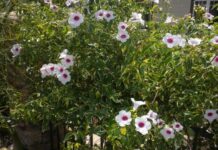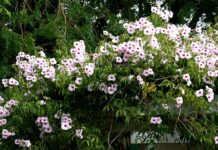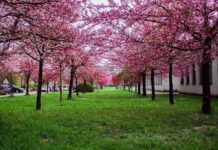
This article about plant Dischidia Imbricata aims to provide a comprehensive guide to everything you need to know, from its history and importance to its care and maintenance.
Whether you are a seasoned gardener or just starting out, this article will help you understand everything you need to know about this fascinating species of plant.
What is Dischidia Imbricata?
Dischidia imbricata is a unique and stunning species of plant native to Southeast Asia. It is a part of the milkweed family and is often referred to as the “Watermelon Hoya.” This name is derived from the distinctive pattern of its leaves, which resemble a watermelon’s rind.
It is a versatile and low-maintenance plant that is perfect for indoor and outdoor gardens. The plant is indigenous in Southeast Asia and is widely cultivated for its beautiful flowers and foliage.
Importance of Dischidia Imbricata in gardening
This is a beautiful plant that is cultivated because of its stunning flowers and foliage. It is a perfect plant to use for outdoors and indoor gardening. The article we’ll discuss the characteristics as well as maintenance and the benefits that this species has to offer.
Overview of Dischidia Imbricata
The description of the plant
Imbricata is an evergreen plant that can grow to 20 feet in length. It is a long, slim and succulent leaves which has a vibrant green color. It produces tiny white flowers which are laid out in groups. The plant is believed to be discovered by an French missionary Pere David, in the latter part of the 19th century.
It was first described scientifically in 1844 by German botanist N.E. Brown. Since the beginning, it has become an extremely popular plant for people who garden and horticulturists, due to its unique appearance and its simple maintenance demands.
Specifications and features
The plant is distinguished by its rapid growth rate as well as its capacity to thrive under many conditions. It is also renowned for its capacity to cleanse the air and has low maintenance needs. It can be described as a tough plant that can thrive in full sun as well as shade.
Habitat and distribution of native species
This amazing plant is indigenous in Southeast Asia and is widely dispersed across the entire region. It is typically located in tropical forests as well as on the banks of streams and roads. The plant is extensively cultivated across many regions around the globe and is a well-loved both in the indoor and outdoors of numerous countries.
Types of Dischidia Imbricata
There are several types of that can be found in different regions around the world. Some of the most popular types are:
Dischidia Ruscifolia
This type is also known as the “Ant Plant”. It is native to Southeast Asia and is known for its unique leaves that have a velvety texture. The leaves of this plant are used by ants to build their nests, hence its name.
Dischidia Nummularia
This is native to tropical regions in Southeast Asia and is known for its small, round leaves that are bright green in color. The plant is known for its trailing growth habit and its ability to grow in low light conditions.
Dischidia Ovata
This type is native to South Asia and is known for its oval-shaped leaves that are light green in color. The plant is known for its ability to grow in high humidity conditions and is often used as an indoor plant in regions with a warm climate.
Dischidia Pectinoides
This type is native to tropical regions in Southeast Asia and is known for its oval-shaped leaves that are green in color with red veins. The plant is known for its trailing growth habit and its ability to grow in low light conditions.
Dischidia Oiantha
This type of is native to tropical regions in Southeast Asia and is known for its green leaves with yellow veins. The plant is known for its trailing growth habit and its ability to grow in high humidity conditions.
Care and Maintenance of Dischidia Imbricata
Dischidia Imbricata, also known as Ant Plant is a very popular species in the landscape sector because of its distinctive appearance and ease of maintenance. It is commonly referred to as the “Ant-Plant” due to its symbiotic relationship with ants.
The plant produces nectar in specialized structures called nectaries, which attracts ants. The ants protect the plant from herbivores and parasites in return for the nectar. This mutualistic relationship is beneficial for both the plant and the ants, hence the name “Ant-Plant.”
Here’s a complete guide to caring:
Watering Requirements
This is an tropical plant that likes an environment with high humidity that is why it has to be regularly watered. It is important to keep the soil wet, but not saturated. Let the top inch of soil dry before watering again.
If the plant is in an environment with low humidity you might need to mist it often to maintain the desired degree of humidity.
Soil and Fertilization
It thrives in a soil that is well-drained and porous. Mixing orchid bark perlite, perlite, and the moss is an excellent choice.
You can fertilize it once a month throughout its growing period (spring through fall) by using the right liquid fertilizer. Limit fertilization during winter, when the plant is into semi-dormant mode.
Light and Temperature Requirements
“She” prefers bright, indirect light, however it is also tolerant of low-light conditions. When the plant is planted in a dark environment it will grow less and get sluggish.
The optimal temp range is between 60-85degF (16-29degC). Do not expose the plant to extreme temperature variations or drafts.
Dischidia Imbricata Pruning and Propagation
It doesn’t need any pruning, however when it becomes excessively leggy, you could trim it back to encourage the growth of bushiness.
The best way to propagate is by cutting stems. Cut stems in spring or summer and then plant the cuttings in water, or a draining mixing of potting soil.
Pests and Diseases
It is largely healthy and free of disease. However, it is susceptible to mealybugs and spider mites, as well as scale insects. Make sure to regularly check the plant for signs of pests and treat them immediately should they be required.
Insufficient watering can cause root rot one of the more frequent disease. It is important to ensure that the soil drains properly and let the top inch of soil to dry prior to applying water once more.
In the end, is a low-maintenance tree that is easy to maintain. If you follow these easy care techniques, you can ensure that your Imbricata is well-nourished and flourishing.
Uses and Benefits of Dischidia Imbricata
Imbricata Dischidia is more than an exquisite plant, it also provides a variety of advantages to gardeners and to the natural environment. Here are a few of the most well-known applications:
For decorative uses
It’s a great choice to create a beautiful décor for both outdoor and indoor spaces. Its lush, green foliage and soft foliage this plant will add the natural look to any space or garden.
It can be presented in a basket that hangs from the ceiling, set on a wall or put in the form of a planter.
Use them in indoor and garden spaces
In addition to its aesthetic beauty, can also be used in gardens as well as indoor areas to create a lush and tropical space. It’s a great choice for those looking to build a low-maintenance beautiful garden without putting in a lot of effort or effort.
Benefits to the environment
It is also a important plant for the ecosystem. It assists in cleaning the air by eliminating harmful toxins. It helps maintain an even temperature and humidity levels in the surrounding area.
FAQs
Here are some commonly asked questions regarding Imbricata Dischidia:
Can Dischidia Imbricata grow in shade?
It is true that is able to grow even in shade, but it is best in indirect, bright sunlight. Beware of exposing it to direct sunlight because this could cause the leaves to get burned.
How can I spread Dischidia Imbricata?
It can be grown from stem cuttings. Simply take a stem cut which has some leaves and put it in a pot filled with water . You can also use a humid soil mix. The stem will grow into roots, and it can be placed in a pot, or planted in the garden.
The type of soil that is suitable to use for Dischidia Imbricata?
This plant prefers well-draining soil which is high of organic matter. You can mix top-quality soils for potting together with perlite and sand in order to increase drainage.
How often do I need to keep my Dischidia Imbricata in good health?
It is recommended to be sure to water it once the soil’s top layer is dry. Be careful not to overwater the plant, since this could cause root decay.
Is Dischidia Imbricata harmful to animals?
This amazing plant isn’t toxic to animals, which makes it a good choice for families with pets. But, it’s important to be vigilant about your pets, particularly those who tend to chew on plants.
It is best that the plants be kept away from access to protect them. This is especially true for youngsters who might be curious and try touching the plant as the stem and leaves could result in skin irritation.
Can this plant grow in pots?
Yes, it can grow in pots. However, it is important to ensure the pot has proper drainage and is appropriately sized for the plant. The soil and fertilizer used should also be suitable for the plant’s growth. Regular watering and exposure to adequate light and temperature are also important for the health and growth.
Conclusion
In the end the Dischidia Imbricata is a beautiful and versatile plant ideal for outdoor and indoor gardening. With its gorgeous green foliage and easy-care requirements it’s a great option for people looking to bring a touch of natural beauty to their home or garden.
It is an amazing plant that is simple to take care of and provides many benefits to gardeners and the surrounding. If you’re seeking to bring a touch natural to your garden or home it is an ideal option







![Rose Names And All Rose Types – The Most Detailed Guide [2022] rose names](https://www.yardious.com/wp-content/uploads/2018/05/rose-names-100x70.jpg)










